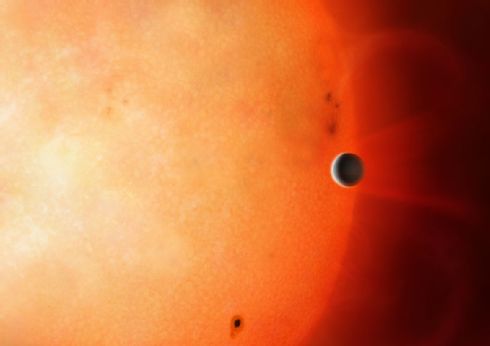Weird alien planet may be core of stripped-down gas giant
The bizarre newfound world resides in the mostly barren 'hot Neptunian desert.'

A distant world about 40 times more massive than Earth may be the remnant core of a giant planet, or a giant planet in the making whose growth stalled, a new study reports.
These findings may help shed light on what the mysterious cores of giant planets look like, researchers said.
Scientists investigated the exoplanet TOI-849b, which NASA's Transiting Exoplanet Survey Satellite (TESS) first detected in 2018 and whose existence the La Silla Observatory in Chile later helped confirm. This alien world orbits the sunlike star TOI-849 about 730 light-years from Earth.
Related: The strangest alien planets (gallery)
With a mass about 40 times that of Earth, TOI-849b is nearly half as massive as Saturn. At the same time, data from the Paranal Observatory in Chile and the Las Cumbres Observatory Global Telescope helped reveal that the exoplanet has a diameter about 3.45 times that of Earth, comparable to Neptune's. Altogether, this information suggests the exoplanet has a density similar to Earth's, making it the densest Neptune-size planet discovered to date.
TOI-849b circles its star in a fast, tight orbit just 18.4 hours long. This brings it scorchingly close to its star at a distance of just 1.5% of an astronomical unit (AU), the average distance between Earth and the sun (which is about 93 million miles, or 150 million kilometers).
The newfound exoplanet therefore lies in the middle of the so-called "hot Neptunian desert," an apparent (and mysterious) dearth of Neptune-size worlds that orbit very close to their stars.
Breaking space news, the latest updates on rocket launches, skywatching events and more!
"There are not a lot of planets in this in-between place, so to see a planet this size this close to a star is pretty cool," Sean Raymond, an astrophysicist at the Observatory of Bordeaux in France, who did not take part in this research, told Space.com.
Previous models suggested that nascent planets more than 10 to 20 times Earth's mass should have strong enough gravitational fields to gobble up huge amounts of material from the protoplanetary disks of gas and dust that surround their newborn stars. Such worlds should therefore swell to become gas giants similar to Jupiter or Saturn. As such, one might think that TOI-849b is the remnant of a gas giant that lost most of its weight somehow, perhaps due to the heat it experiences orbiting so close to its star.
However, as much as the light from TOI-849b's star would sear the exoplanet, the scientists noted such heating alone might still not strip a gas giant's atmosphere down to nearly the planet's core. They estimated the star is about 6.7 billion years old. Given that amount of time, as well as TOI-849b's distance from its star, they calculated a Jupiter-like gas giant would have lost only a few percent of its mass due to stellar radiation to date.
As such, the researchers suggest that TOI-849b may be the remnant core of a gas giant that lost mass through a different mechanism. Perhaps it collided with other giant planets, for example, or the gravity of its star peeled off much of its gas envelope. Alternatively, if TOI-849b were slung to its current position due to gravitational clashes with other planets, the energy the exoplanet would have experienced as its star's gravity pulled TOI-849b into its current circular orbit would have greatly heated that world, potentially leading to significant mass loss.
Another possible explanation for TOI-849b's current state has to do with arrested development. Perhaps TOI-849b formed late, when much of its system's protoplanetary disk was gone, the researchers said. Alternatively, perhaps as TOI-849b developed in orbit around its star, it carved off all the material available to it for its growth within the protoplanetary disk.
All in all, TOI-849b may give scientists a glimpse at what the core of a gas giant looks like. Future research may directly observe that core's composition by analyzing evaporated material in the exoplanet's remaining atmosphere.
Further work may also investigate whether this exoplanet actually was a gas giant whose atmosphere was stripped away by the light from its star.
"They claim that it's unlikely, but these calculations are hard to do," Raymond said.
The new study, which was led by David Armstrong of the University of Warwick in England, has been accepted by the journal Nature. You can read a preprint of the paper for free at arXiv.org.
- 7 ways to discover alien planets
- NASA's TESS exoplanet-hunting mission in pictures
- NASA's TESS is finding hundreds of exoplanets. It's poised to find thousands more
Follow Charles Q. Choi on Twitter @cqchoi. Follow us on Twitter @Spacedotcom and on Facebook.
OFFER: Save 45% on 'All About Space' 'How it Works' and 'All About History'!
For a limited time, you can take out a digital subscription to any of our best-selling science magazines for just $2.38 per month, or 45% off the standard price for the first three months.

Charles Q. Choi is a contributing writer for Space.com and Live Science. He covers all things human origins and astronomy as well as physics, animals and general science topics. Charles has a Master of Arts degree from the University of Missouri-Columbia, School of Journalism and a Bachelor of Arts degree from the University of South Florida. Charles has visited every continent on Earth, drinking rancid yak butter tea in Lhasa, snorkeling with sea lions in the Galapagos and even climbing an iceberg in Antarctica. Visit him at http://www.sciwriter.us

